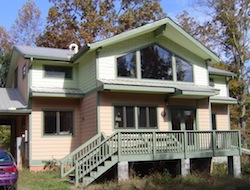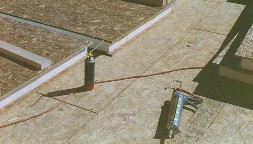Do You Need an Extreme Home Makeover to Get a Soundproof Home?

Recently I saw an episode of Extreme Home Makeover in which Ty Pennington and crew built a house for an Iraq war veteran with post-traumatic stress disorder (PTSD). Because noise was a huge trigger for the stress attacks he experienced frequently, they wanted to build him a soundproof home. They even included an inner sanctum with extreme measures of soundproofing where he could feel completely safe and protected.
About 10 years ago, I built a house that was extremely quiet, too. It didn’t include the extreme measures of the Extreme Home Makeover project, but here’s how quiet it was: We had a gravel driveway. If we were inside with all the doors and windows closed, we couldn’t hear a thing when someone drove up to the house. We didn’t know anyone was there until they knocked on the door.
Soundproofing wasn’t one of our aims when we designed and built the house. In fact, since we lived on 66 acres five miles outside of a small town, I would’ve preferred a building envelope that let all the sounds in. I loved listening to the whip-poor-wills and chuck-wills-widows, the cicadas and katydids, and the occasional pack of coyotes. To hear those things, though, we either had to go outside or open the windows and doors, which we did as often as we could.
How did we do it? The house was quiet because of:
- Air sealing (1.7 ACH50)
- Solid foam insulation in the structural insulated panels
- Double pane windows
Sound is a wave that travels through materials. Unlike light and heat, it cannot travel through empty space, but it does travel easily through air. That’s why air sealing should be the first step you take if you’re building a new home or fixing an existing home and want to limit the noise coming in.
a new home or fixing an existing home and want to limit the noise coming in.
Here’s an example of the importance of air sealing. In 2006, I moved out of that high performance home (That’s another story) and, for a while, into an 80 year old bungalow in Decatur (a city that’s part of what most people think of as Atlanta). There was no insulation in the walls, and air passed through the building envelope more easily than the Aaron Rodgers-led Green Bay Packers pass through opposing defenses. When I was at home, it sometimes felt like there was no sound buffer at all.
If you’re going for true soundproofing to help someone with PTSD, as the Extreme Home Makeover crew did, or for your home theater or maybe a recording studio, you can take a number of other steps. You could incorporate products like concrete, resilient channels, soundproof drywall, and acoustic foam. You could also use special framing methods like staggered studs or, as I did, structural insulated panels. No matter what level of soundproofing you’re going for, though, you’ll still start with air sealing.
Allison A. Bailes III, PhD is a speaker, writer, building science consultant, and the founder of Energy Vanguard in Decatur, Georgia. He has a doctorate in physics and is the author of a bestselling book on building science. He also writes the Energy Vanguard Blog. For more updates, you can follow Allison on LinkedIn and subscribe to Energy Vanguard’s weekly newsletter and YouTube channel.
Related Articles
Soundproofing a Wall – The Basics
How to Fix a Leaky, Underinsulated Exterior Wall
A Layered Approach to Indoor Air Quality
Comments are closed.
This Post Has 7 Comments
Comments are closed.

Yes, we have hundreds of
Yes, we have hundreds of Sound Reducing retrofitted jobs, at condo’s where home owners, developers, were not use to hearing neighbors. Also psychologist’s want sound mitigation between their own rooms. Dense packing insulation works. Got to stop sounding off and get to work!
My very first major retrofit
My very first major retrofit job had this type of result. We were not attempting to soundproof.
We came back months later and this is what the customer was raving about the most.
Sound is a greatly overlooked comfort issue.
Smaller lot sizes = more need
Smaller lot sizes = more need for soundproofing. Please!
Great post, as usual, Allison. This is one topic that needs more awareness.
A brick exterior goes a long
A brick exterior goes a long way towards soundproofing.
Dennis:
Dennis: What have you found to be the most effective methods and materials in all your soundproofing jobs?
Christopher C.: In cities and suburban neighborhoods, soundproofing may well be one the qualities in a home that people want most. And, as you say, it’s often overlooked.
Nora: Thanks! Good point about smaller lots, too.
Bob: High density materials help prevent the transmission of sound, so brick definitely helps with that.
Matt Risinger’s blog at Fine
Matt Risinger’s blog at Fine Homebuilding has some interesting tips on sound proofing. Check the links here and here.
Allison,
Allison,
It’s nice to see your house again after all of these years. I’m glad to hear that it still offers some lessons to learn from.